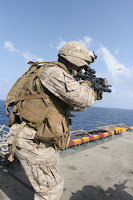
The exercise was a ship-to-shore training evolution designed to strengthen Navy and Marine Corps amphibious capabilities and involved service members from the USS New Orleans (LPD 18), USS Comstock (LSD 45) and 13th MEU.
“As the MEU we are the floating reserve for U.S. Central Command,” said Lt. Col. Tye R. Wallace, Commanding Officer, Battalion Landing Team 1/1. “In that capacity, we have to be ready to go anywhere in the area of operations and perform any of our standard MEU missions.”
Marines were joined by the French Foreign Legion throughout the exercise, giving both military forces a chance to learn from each other.
“We mainly paired the French Foreign Legion with Alpha Company to do combined exercises,” said Wallace. “They did some small unit infantry training and practiced room search operations to help train French forces.”

Wallace said Alpha Company conducted other training with amphibious assault vehicles and tanks to familiarize the French with U.S. Marine Corps operations.
“We also brought some of the French Officers and Legionnaires aboard the ship to give them a tour,” said Wallace. “This was to build relationships between the two companies and to show them how we live out on the sea.”
Wallace said he hopes this exercise will be a stepping stone for follow-on MEU’s to do something similar and continue to build working relationships.
“I think we came out of the exercise stronger than when we came in,” he said. “We have identified any issues and taken corrective action to bring ourselves back up to our full capabilities.”
Weapons Company, BLT 1/1, also tested some of their equipment ashore while conducting field operations.
 Staff Sgt. Steven E. Williams, platoon sergeant for Weapons Company, said they wanted to put some rounds down range to keep up to date on marksmanship skills. This gave Weapons Company an opportunity to get some time out in the field to build unit cohesion.
Staff Sgt. Steven E. Williams, platoon sergeant for Weapons Company, said they wanted to put some rounds down range to keep up to date on marksmanship skills. This gave Weapons Company an opportunity to get some time out in the field to build unit cohesion.“I know it was really hot out here, but both new Marines and those who have been with us for awhile learned something,” he said. “It was good to get off the ship and get some training in. I think the Marines really enjoyed themselves; I know the French did as well.”
The 13th MEU and Boxer Amphibious Ready Group are currently on a deployment in support of regional and Maritime Security Operations (MSO).
In addition to BLT 1/1, the MEU is composed of its Command Element, Marine Medium Helicopter Squadron 163 (Reinforced), and Combat Logistics Battalion 13.







Marines with Weapons Company, 13th Marine Expeditionary Unit embarked aboard USS New Orleans (LPD 18) set up a position on a mountainside after driving all night in an ambush training exercise during Boxer Amphibious Ready Group (ARG) and 13th Marine Expeditionary Unit (MEU) exercise May 23.

 Lance Cpl. Jose M. Garcia, machine gunner with Charlie Company, BLT 1/1, from Los Angeles helps store fresh boxes of milk which arrived during the USS Boxer's vertical replenishment May 27.
Lance Cpl. Jose M. Garcia, machine gunner with Charlie Company, BLT 1/1, from Los Angeles helps store fresh boxes of milk which arrived during the USS Boxer's vertical replenishment May 27.









 Gothard says when the ship does pull into port, lines form in front of his window and the exchanging of cash begins.
Gothard says when the ship does pull into port, lines form in front of his window and the exchanging of cash begins. Gothard started preparing and planning for his future early on when he joined and believes the skills he will learn here will help him accomplish his goals.
Gothard started preparing and planning for his future early on when he joined and believes the skills he will learn here will help him accomplish his goals. Marines with Weapons Platoon, Charlie Company, Battalion Landing Team 1/1, 13th Marine Expeditionary Unit, line up on the firing line during training in the Combat Marksmanship Program on the flight deck of USS Boxer (LHD 4) May 11.
Marines with Weapons Platoon, Charlie Company, Battalion Landing Team 1/1, 13th Marine Expeditionary Unit, line up on the firing line during training in the Combat Marksmanship Program on the flight deck of USS Boxer (LHD 4) May 11.  Cpl. Estuardo A. Zamora, team leader with 1st Platoon, Charlie Company, Battalion Landing Team 1/1, 13th Marine Expeditionary Unit (MEU) happily serves breakfast to Marines aboard USS Boxer (LHD 4) May 8.
Cpl. Estuardo A. Zamora, team leader with 1st Platoon, Charlie Company, Battalion Landing Team 1/1, 13th Marine Expeditionary Unit (MEU) happily serves breakfast to Marines aboard USS Boxer (LHD 4) May 8.  Sgt. Hugh Clark, intelligence systems chief with the 13th Marine Expeditionary Unit, helps Marines in the human-chain to get mail to the staging area for distribution. The sorting of mail usually takes three to five hours.
Sgt. Hugh Clark, intelligence systems chief with the 13th Marine Expeditionary Unit, helps Marines in the human-chain to get mail to the staging area for distribution. The sorting of mail usually takes three to five hours.  Marines with Reconnaissance and Surveillance Platoon, Battalion Landing Team 1/1, 13th Marine Expeditionary Unit, practice boat offloading maneuvers during Combat Rubber Reconnaissance Craft (CRRC) training operations, May 4, after testing their new, multifuel experimental boat engines.
Marines with Reconnaissance and Surveillance Platoon, Battalion Landing Team 1/1, 13th Marine Expeditionary Unit, practice boat offloading maneuvers during Combat Rubber Reconnaissance Craft (CRRC) training operations, May 4, after testing their new, multifuel experimental boat engines.  Rear Adm. Michelle Howard, commander of Expeditionary Strike Group (ESG) 2, expresses her gratitude towards the Sailors and Marines of the 13th Marine Expeditionary Unit and Boxer Amphibious Ready Group for their hard work during the past two months while conducting counter-piracy operations off the coast of Africa.
Rear Adm. Michelle Howard, commander of Expeditionary Strike Group (ESG) 2, expresses her gratitude towards the Sailors and Marines of the 13th Marine Expeditionary Unit and Boxer Amphibious Ready Group for their hard work during the past two months while conducting counter-piracy operations off the coast of Africa. Marines with the 13th Marine Expeditionary Unit stand at parade rest while they wait to be addressed by Rear Adm. Michelle Howard, commander of Expeditionary Strike Group (ESG) 2, aboard amphibious assault ship USS Boxer (LHD 4).
Marines with the 13th Marine Expeditionary Unit stand at parade rest while they wait to be addressed by Rear Adm. Michelle Howard, commander of Expeditionary Strike Group (ESG) 2, aboard amphibious assault ship USS Boxer (LHD 4). 









 1st Lt. Patrick J. Zuber, platoon commander of 81mm Mortar Platoon, Weapons Company, BLT 1/1, 13th MEU, and Boston, Mass. native, gives a safety brief to over 100 Marines and sailors before beginning fast-rope training aboard USS Boxer May 9.
1st Lt. Patrick J. Zuber, platoon commander of 81mm Mortar Platoon, Weapons Company, BLT 1/1, 13th MEU, and Boston, Mass. native, gives a safety brief to over 100 Marines and sailors before beginning fast-rope training aboard USS Boxer May 9.


 SA-330J Puma helicopters transfer mail and essential gear from the Military Sealift Command dry cargo/ammunition ship USNS Lewis and Clark (T-AKE 1) to the flight-deck of USS Boxer (LHD 4) during a replenishment at sea (RAS) operation here. The Lewis and Clark is a Combat Logistics Force Underway Replenishment Naval vessel that resupplies ships with ammunition, food, limited quantities of fuel, repair parts, ship store items and expendable supplies.
SA-330J Puma helicopters transfer mail and essential gear from the Military Sealift Command dry cargo/ammunition ship USNS Lewis and Clark (T-AKE 1) to the flight-deck of USS Boxer (LHD 4) during a replenishment at sea (RAS) operation here. The Lewis and Clark is a Combat Logistics Force Underway Replenishment Naval vessel that resupplies ships with ammunition, food, limited quantities of fuel, repair parts, ship store items and expendable supplies.  A working party of Marines and Sailors stage incoming mail by forming a human-chain in the hangar bay of the amphibious assault ship USS Boxer (LHD 4). The staging and sorting of mail usually takes from three to five hours.
A working party of Marines and Sailors stage incoming mail by forming a human-chain in the hangar bay of the amphibious assault ship USS Boxer (LHD 4). The staging and sorting of mail usually takes from three to five hours. Lance Cpl. Phillip M. Timmons, administrative clerk with the Command Element of the 13th Marine Expeditionary Unit, smiles as he passes a box down the line to the mail staging area during replenishment at sea (RAS) operations here. The sorting of mail usually takes from three to five hours.
Lance Cpl. Phillip M. Timmons, administrative clerk with the Command Element of the 13th Marine Expeditionary Unit, smiles as he passes a box down the line to the mail staging area during replenishment at sea (RAS) operations here. The sorting of mail usually takes from three to five hours.

 Marines with Reconnaissance and Surveillance Platoon, Battalion Landing Team 1/1, 13th Marine Expeditionary Unit, practice boat offloading maneuvers during Combat Rubber Reconnaissance Craft (CRRC) training operations, May 4, after testing their new, multifuel experimental boat engines.
Marines with Reconnaissance and Surveillance Platoon, Battalion Landing Team 1/1, 13th Marine Expeditionary Unit, practice boat offloading maneuvers during Combat Rubber Reconnaissance Craft (CRRC) training operations, May 4, after testing their new, multifuel experimental boat engines. Marines with Reconnaissance and Surveillance Platoon, Battalion Landing Team 1/1, 13th Marine Expeditionary Unit, jump out of the back of a CH-46E helicopter during Combat Rubber Reconnaissance Craft (CRRC) operations May 24, in order to test their new, multifuel experimental boat engines. Marines also conducted maneuver training, high-speed cast and recovery drills and landings on the stern gate of amphibious assault ship USS Boxer (LHD 4).
Marines with Reconnaissance and Surveillance Platoon, Battalion Landing Team 1/1, 13th Marine Expeditionary Unit, jump out of the back of a CH-46E helicopter during Combat Rubber Reconnaissance Craft (CRRC) operations May 24, in order to test their new, multifuel experimental boat engines. Marines also conducted maneuver training, high-speed cast and recovery drills and landings on the stern gate of amphibious assault ship USS Boxer (LHD 4). Marines with Reconnaissance and Surveillance Platoon, Battalion Landing Team 1/1, 13th Marine Expeditionary Unit, turn over their boat just after jumping out of a CH-46E helicopter during Combat Rubber Reconnaissance Craft (CRRC) operations May 24, in order to test their new, multifuel experimental boat engines. Marines also conducted maneuver training, high-speed cast and recovery drills and landings on the stern gate of amphibious assault ship USS Boxer (LHD 4).
Marines with Reconnaissance and Surveillance Platoon, Battalion Landing Team 1/1, 13th Marine Expeditionary Unit, turn over their boat just after jumping out of a CH-46E helicopter during Combat Rubber Reconnaissance Craft (CRRC) operations May 24, in order to test their new, multifuel experimental boat engines. Marines also conducted maneuver training, high-speed cast and recovery drills and landings on the stern gate of amphibious assault ship USS Boxer (LHD 4).

 Marines with Reconnaissance and Surveillance Platoon, Battalion Landing Team 1/1, 13th Marine Expeditionary Unit, successfully test their new, experimental Combat Rubber Reconnaissance Craft (CRRC) engines during training operations, May 24. Marines also conducted maneuver training, high-speed cast and recovery drills and landings on the stern gate of amphibious assault ship USS Boxer (LHD 4).
Marines with Reconnaissance and Surveillance Platoon, Battalion Landing Team 1/1, 13th Marine Expeditionary Unit, successfully test their new, experimental Combat Rubber Reconnaissance Craft (CRRC) engines during training operations, May 24. Marines also conducted maneuver training, high-speed cast and recovery drills and landings on the stern gate of amphibious assault ship USS Boxer (LHD 4).